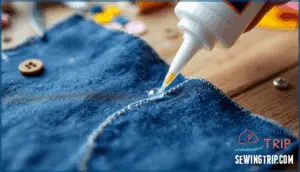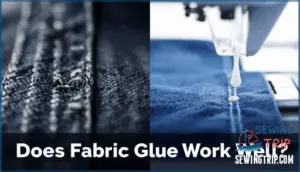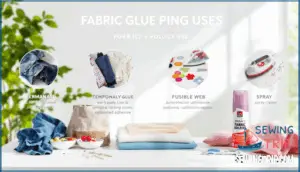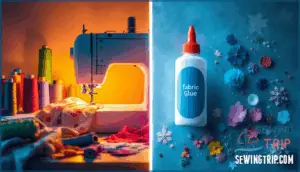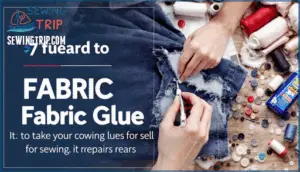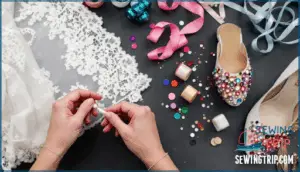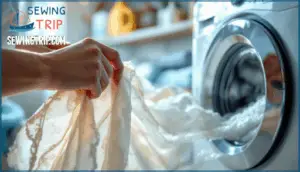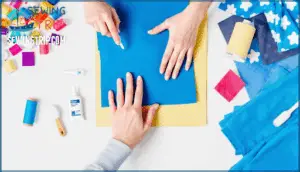This site is supported by our readers. We may earn a commission, at no cost to you, if you purchase through links.
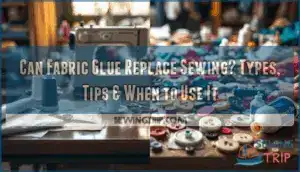 A torn hem before a big meeting, a costume emergency five minutes before curtain call—sometimes, sewing feels more like a luxury than a solution. Fabric glue promises a shortcut: no needle, no thread, just a squeeze and press. The idea sounds almost too good to be true.
A torn hem before a big meeting, a costume emergency five minutes before curtain call—sometimes, sewing feels more like a luxury than a solution. Fabric glue promises a shortcut: no needle, no thread, just a squeeze and press. The idea sounds almost too good to be true.
Can fabric glue replace sewing for repairs, embellishments, or everyday fixes? If you’ve wondered whether glue can endure where stitches used to rule, you’re not alone. Understanding the strengths and limits of fabric adhesives can help you decide when to reach for the bottle and when to thread the needle.
Table Of Contents
- Key Takeaways
- When to Use Fabric Glue
- Is Fabric Glue Permanent
- Does Fabric Glue Work Well
- How to Apply Fabric Glue
- Types of Fabric Glue
- Fabric Glue Vs Sewing
- Using Fabric Glue for Repairs
- Fabric Glue for Embellishments
- Washing Items With Fabric Glue
- Tips for Fabric Glue Success
- Frequently Asked Questions (FAQs)
- Conclusion
Key Takeaways
- Fabric glue offers a fast solution for temporary repairs and embellishments, but can’t match sewing for strength and long-term durability.
- Permanent fabric glues can survive dozens of washes if fully cured, while temporary types are best for quick fixes and testing placements.
- Successful bonding depends on choosing the right glue for your material, using thin, even layers, and allowing proper curing time.
- Glue works well for attaching decorations, fixing loose seams, and mending various fabrics, but may affect breathability and isn’t recommended for children’s clothing.
When to Use Fabric Glue
When you need a temporary fix or quick embellishment, fabric glue steps in like a shortcut that skips the threading and stitching altogether. It’s perfect for no-sew projects where you’re racing the clock—think costume emergencies, last-minute hem adjustments, or tacking on patches without hunting for your needle. Temporary fabric bonds let you test placements before committing, while permanent fabric bonds take care of repairs that need to stick around.
Crafting applications shine here: you can attach sequins, ribbons, or appliques to bags and pillows without wrestling with delicate fabric projects that might pucker under a machine needle. Sewing alternatives like fabric glue give you freedom when working with unconventional materials—felt, tulle, or vinyl—that don’t play nice with traditional stitching.
Quick project uses also include hemming curtains or fixing split seams on backpacks. Fabric glue for repairs saves the day when buttons pop off or decorative trim loosens, while fabric glue for embellishments makes personalizing gear simple and fast.
Is Fabric Glue Permanent
Fabric glue comes in permanent and temporary forms, and your choice depends on whether the bond lifespan matters. Permanent fabric glue creates bonds built to last—brands like Gorilla Fabric Glue and Tear Mender survive 30+ machine washes while holding about 80% of their original strength. These permanent adhesives resist cracking, peeling, and moisture for years when fully cured.
Removal methods for permanent fabric bonds require solvents, since glue adjustability vanishes once the adhesive sets. Heat resistance varies by product, so check labels before ironing. Material compatibility also matters: permanent alterations or repairs work best on cotton and denim, while delicate fabrics need gentler options. Some brands like E6000 offer flexibility and superior bond strength.
- Curing time is your commitment period: Permanent fabric glue needs 24–72 hours to lock in, and some formulas require up to 10 days before the first wash—rushing that timeline turns "permanent" into "peeling.
Does Fabric Glue Work Well
Proper technique separates strong bonds from peeling disasters. Lab studies show premium adhesives like E6000 and Gorilla Fabric Glue achieve bond strength where "the fabric tore before the glue failed"—especially on denim and cotton. Fabric compatibility matters: natural fibers bond reliably with general-purpose formulas, while synthetics and leather need specialized products.
With the right technique and adhesive, fabric glue can create bonds so strong that the fabric tears before the glue fails
For everyday repairs, Aleene’s Fabric Fusion is a non-toxic and water-based option. Washability tests confirm top performers survive 30+ laundry cycles when fully cured for 24–72 hours.
Application factors like even coating and controlled thickness directly affect comparative performance—too much glue reduces strength by up to 21%. You’ll get sewing-level results if you match the right adhesive to your material and follow curing guidelines.
How to Apply Fabric Glue
Clean fabric first—glue won’t stick to dust, oils, or lint no matter how strong the adhesive. Wipe both surfaces with rubbing alcohol and let them dry completely. Apply a thin, even layer—proper gluing technique means less is more. Too much creates stiff, visible seams. Press firmly for 10–15 seconds, then secure with clips or weights during drying. Most adhesives need 24–72 hours to cure fully before touching or washing.
Surface preparation and testing bond strength prevent common mistakes:
- Test first: Try your fabric glue application on scrap pieces to check flexibility and adhesion
- Control glue quantity: Thin coats prevent stiffness and oozing better than thick application
- Use pressure application: Clamps or heavy books make certain maximum contact during drying techniques
Types of Fabric Glue
Choosing the right adhesive makes the difference between a repair that lasts and one that falls apart after a single wash. Liquid adhesives dry flexible and clear, working well on natural and synthetic fibers. Spray adhesive covers large areas fast—think upholstery or quilt backing. Fusible web needs heat from an iron to bond, creating strong, washable seams. Glue sticks offer quick application but can feel stiff. Specialty glues target specific materials like leather or stretch fabrics. Here’s what you’ll find:
| Type | Best For |
|---|---|
| Permanent fabric glue | Repairs needing wash durability |
| Temporary fabric glue | Basting seams before stitching |
| Fusible web | Hems and appliqués |
| Spray adhesive | Large surface bonding |
Fabric Glue Vs Sewing
Sometimes, speed matters more than tradition. If you’re weighing fabric glue vs sewing, consider this: glue wins for quick fixes, embellishments, and lightweight fabrics, but sewing still holds the crown for strength and repeated stress. Application time is shorter with glue—think minutes instead of half an hour. Durability tests show sewing lasts longer, especially after many washes. For cost comparison, glue is slightly pricier per use.
Here’s a look:
| Bond Strength | Application Time | Cost Comparison |
|---|---|---|
| Sewing: Strongest | Sewing: Longer | Sewing: Cheaper |
| Glue: Moderate | Glue: Fastest | Glue: Slightly Higher |
Using Fabric Glue for Repairs
When you spot a rip or loose seam on your favorite bag or jeans, reaching for fabric glue can save you time and hassle. Instead of wrestling with a needle, you can manage clothing repairs, Seam Re-sealing, or Patch Application in just minutes. Clean the torn fabric first, then apply a thin line of glue along both edges. Press together for about a minute, and let it cure—some glues set in five minutes, others take longer for permanent alterations or repairs.
Fabric glue for repairs works on leather, canvas, cotton, vinyl, and even delicate silk. For instance, Tear Mending on hats, Hem Repairs on pants, or Upholstery Fixes on cushions become simple tasks. If you need to reattach a loose sole, mend a broken strap, or fix carpet seams, fabric glue offers reliable bonding without bulky stitches. It’s a practical way to restore function and keep your cherished items looking sharp.
Fabric Glue for Embellishments
Ever wondered how to add a splash of personality to your clothes or accessories without picking up a needle? Fabric glue for embellishments is your shortcut to creative freedom. Instead of sewing, you can attach decorative elements—sequins, beads, ribbons, or patches—with just a dab of glue. This method works especially well on delicate fabrics where stitches might cause damage. For bead adhesion or securing embellishments, glue application is quick and precise. You get design flexibility too, since temporary glues let you reposition before the bond sets. Permanent formulas keep things in place for the long haul.
Try fabric glue for embellishments when you want:
- Secure Embellishments on shoes, hats, or bags
- Quick fixes for costume pieces
- Easy attachment of decorative elements
- Gentle bonding for Delicate Fabrics
Washing Items With Fabric Glue
Did you know fabric glue can survive up to 30 wash cycles if you treat it right? Protect your bond by following these four steps:
- Always allow full curing time before washing.
- Use cold water and mild detergent—skip bleach.
- Choose gentle washing machine cycles to minimize agitation.
- Air dry whenever possible; high heat weakens glue bonds.
Treat glued fabrics with care, and you’ll keep your repairs and embellishments strong, flexible, and looking fresh through every wash.
Tips for Fabric Glue Success
Getting the most out of fabric glue is a bit like baking bread—success comes down to the right prep, patience, and a little pressure. If you want strong, lasting results, start with surface preparation. Clean your fabrics well; dust and oils weaken the bond.
Next, focus on glue application. Use a thin, even layer, and don’t overdo it—too much glue can make seams stiff or messy. Pressure techniques matter, too. After joining your fabrics, press them firmly together, using your hands or a weighted object for best results.
Frequently Asked Questions (FAQs)
Can fabric glue be used on all types of fabric?
Think of fabric glue like a bridge—it connects most fabrics, but not all roads are smooth. Fiber compatibility, glue absorption, and texture effects matter.
Always test on delicate fabrics and synthetics; weight limits and material reactions can surprise you.
Can fabric glue be used to attach buttons or zippers?
Attaching buttons or zippers with fabric glue works for quick fixes. For Button Glue Strength and Zipper Glue Types, coat both surfaces, align carefully, and let cure fully.
Fabric Compatibility matters—test first for Long-Term Durability and secure Application Techniques.
Will fabric glue hold up well in the washing machine?
Strong bonds, flexible seams, invisible repairs—fabric glue can withstand the washing machine if you choose the right glue type, water temperature, and drying method.
Washability and durability depend on glue choice and fabric, so follow instructions carefully.
Is fabric glue safe for sensitive skin?
Fabric glue can cause skin irritation or glue allergies, especially with certain adhesive ingredients. If you have toxicity concerns or sensitive skin, try safe alternatives and always patch test first on delicate fabrics before using.
Can fabric glue bond leather and suede?
Picture patching a worn leather jacket—leather glue types offer solid adhesive bonds, but suede bond strength varies. For heavy-duty materials, use glue application tips for durability on leather.
Leather repair options depend on fabric glue on different fabrics.
Does fabric glue affect fabric breathability?
Applying adhesive to textiles can block airflow, especially if glue layer thickness is high or glue pore size is small.
Breathability testing methods show natural fibers retain more air than synthetic materials, but long-term effects depend on fabric type impact.
Is fabric glue suitable for outdoor fabrics?
Did you know some UV-resistant fabric glues can last three years outdoors with less than 5% mass loss?
For outdoor fabrics, choose waterproof, durable glue and check bond durability for weather exposure. Application methods and fabric type matter, too.
Can fabric glue be used on children’s clothing?
You’ll want to avoid fabric glue for children’s clothing due to glue toxicity, choking hazards, skin sensitivity, and durability concerns. Clothing regulations often restrict its use.
For crafting with kids, choose non-toxic, washable adhesives on delicate fabrics.
Conclusion
It’s funny how a bottle of fabric glue can sit unnoticed until the day you need a quick fix. When you’re racing the clock, you might wonder: can fabric glue replace sewing for good?
The answer depends on your project’s demands—sometimes glue holds strong, other times only stitches will do. Knowing when to trust glue gives you freedom, but respecting its limits keeps your creations lasting.
Think of glue as a helpful sidekick, not a permanent stand-in.
- https://www.magnetichoop.com/blogs/news/mastering-fabric-glue-how-to-choose-use-and-get-the-best-results
- https://www.maggieframes.com/blogs/embroidery-blogs/patch-glue-for-fabric-ultimate-no-sew-attachment-guide-top-solutions
- https://www.nature.com/articles/s41598-024-73987-4
- https://www.hooptalent.com/blogs/news/washable-fabric-glue-choosing-non-toxic-adhesives-that-survive-laundry
- https://www.zdschemical.com/blog/fabric-glue/

